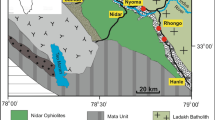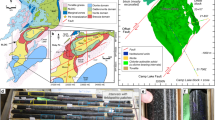Abstract
This paper considers the distribution of trace elements (including rare earth elements) in zircons dated by the ion-microprobe U-Th-Pb isotope method and its genetic implications. Two problems were addressed on the basis of the investigation of trace element compositions of zircons: (1) genesis of zircons from subalkaline magmatic rocks, sysenites, and sanukitoids and their comparison with tonalites as exemplified by the rocks of the Karelian region, and (2) determination of trace element signatures of zircons from the oldest granulite-facies rocks of the Ukrainian shield. It was shown that the REE distribution patterns of the tonalites, which crystallized in equilibrium with melt, are strictly governed by crystal-chemical laws. The REE distribution patterns show a positive slope with an increase from La to Lu, a positive Ce anomaly, and a negative Eu anomaly. Similar patterns were observed in zircons from the syenites. The trace element contents of zircons are related to those of melts through partition coefficients. Zircons from the sanukitoids show a considerable LREE enrichment, which is inconsistent with the calculated zircon/melt partition coefficients and presumably related to the inherently imperfect zircon structure. Such a structure was formed during zircon crystallization from melt at high temperatures and the anomalous fluid regime that is characteristic, in particular, of sanukitoid melts. The REE distribution patterns of zircons that crystallized under granulite-facies conditions are sharply different from typical distributions in HREE depletion, which was caused by the competitive growth of garnet during zircon crystallization.
Similar content being viewed by others
References
J. A. Speer, “Zircon,” in Orthosilicates, Ed. by P. H. Ribbe, Rev. Mineral. 5, 67–112 (1980).
S. S. Ramakrishnan, K. V. G. K. Gokhale, and E. C. Subbarao, “Solid Solubility in the System Zircon-Hafnon,” Mater. Res. Bull. 4, 323–327 (1969).
E. B. Watson, D. J. Cherniak, J. M. Hanchar, et al., “The Incorporation of Pb into Zircon,” Chem. Geol. 141, 19–31 (1997).
P. W. O. Hoskin and U. Schaltegger, “The Composition of Zircon and Igneous and Metamorphic Petrogenesis,” in Zircons, Ed. by J. M. Hanchar and P. W. O. Hoskin, Rev. Mineral. Geochem. 53, 27–62 (2003).
J. M. Hanchar, R. J. Finch, P. W. O. Hoskin, et al., “Rare-Earth Elements in Synthetic Zircon. Part 1,” Am. Mineral. 86, 667–680 (2001).
R. J. Finch, J. M. Hanchar, P. W. O. Hoskin, and P. C. Burns, “Rare-Earth Elements in Synthetic Zircon: Part 2. A Single-Crystal X-Ray Study of Xenotime Substitution,” Am. Mineral. 86, 681–689 (2001).
N. Rayner, R. A. Stern, and S. D. Carr, “Grain-Scale Variations in Trace Element Composition of Fluid-Altered Zircon, Acasta Gneiss Complex, Northwestern Canada,” Contrib. Mineral. Petrol. 148, 721–734 (2005).
R. W. Hinton and B. G. J. Upton, “The Chemistry of Zircon: Variations within and between Large Crystals from Syenite and Alkali Basalt Xenoliths,” Geochim. Cosmochim. Acta 55, 3287–3302 (1991).
G. A. Snyder, L. A. Taylor, and G. Crozaz, “Zircon/Melt Partition Coefficients for the Rare-Earth Elements in Evolved Rocks: The Usefulness of Accessory Minerals in Petrogenetic Studies on the Earth and Moon,” Lunar Planet. Sci. Conf. 23, 1323–1324 (1992).
T. R. Ireland and F. Wlotzka, “The Oldest Zircons in the Solar System,” Earth Planet. Sci. Lett. 109, 1–10 (1992).
D. Rubatto, “Zircon Trace Element Geochemistry: Partitioning with Garnet and the Link between U-Pb Ages and Metamorphism,” Chem. Geol. 184, 123–138 (2002).
N. M. Halden, F. C. Hawthorne, J. L. Campbell, et al., “Chemical Characterization of Oscillatory Zoning and Overgrowths in Zircon Using 3 MeV μ-PIXE,” Can. Mineral. 31, 637–647 (1993).
E. M. Es’kova, “Geochemistry of Nb and Ta in the Vishnevye Gory Nepheline Syenite Massifs,” Geokhimiya, No. 2, 130–139 (1959).
U. Poller, J. Huth, P. Hoppe, and I. S. Williams, “REE, U, Th, and Hf Distribution in Zircon from Western Carpathian Variscian Granitoids: A Combined Cathodoluminescence and Ion Microprobe Study,” Am. J. Sci. 301, 585–876 (2001).
R. T. Pidgeon, “Zircons: What We Need to Know,” J. R. Soc. West. Austr. 79, 119–122 (1996).
P. W. O. Hoskin and T. R. Ireland, “Rare Earth Element Chemistry of Zircon and Its Use as a Provenance Indicator,” Geology 28, 627–630 (2000).
M. J. Whitehouse and J. P. Platt, “Dating High-Grade Metamorphism—Constraints from Rare-Earth Elements in Zircon and Garnet,” Contrib. Mineral. Petrol. 145, 61–74 (2003).
J. Hermann, D. Rubatto, A. Korsakov, and V. S. Shatsky, “Multiple Zircon Growth during Fast Exhumation of Diamondiferous, Deeply Subducted Continental Crust (Kokchetav Massif, Kazakhstan),” Contrib. Mineral. Petrol. 141, 66–82 (2001).
M. J. Whitehouse and B. S. Kamber, “On the Overabundance of Light Rare Earth Elements in Terrestrial Zircons and Its Implication for Earth’s Earliest Magmatic Differentiation,” Earth Planet. Sci. Lett. 204, 333–346 (2002).
P. W. O. Hoskin, “Trace-Element Composition of Hydrothermal Zircon and the Alteration of Hadean Zircon from the Jack Hills, Australia,” Geochim. Cosmochim. Acta 69, 637–648 (2005).
E. A. Belousova, W. L. Griffin, S. Y. O’Reilly, and N. I. Fisher, “Igneous Zircon: Trace Element Composition as an Indicator of Source Rock Type,” Contrib. Mineral. Petrol. 143, 602–622 (2002).
E. A. Belousova, W. L. Griffin, and N. J. Pearson, “Trace Element Composition and Cathodoluminescence Properties of Southern African Kimberlitic Zircons,” Mineral. Mag. 62, 355–366 (1998).
P. W. O. Hoskin, “Minor and trace element analysis of natural zircon (ZrSiO4) by SIMS and Laser Ablation ICPMS: A Consideration and Comparison of Two Broadly Competitive Techniques,” J. Trace Microprobe Tech. 16, 301–326 (1998).
J. B. Thomas, R. J. Bodnar, N. Shimizu, and A. K. Sinha, “Determination of Zircon/Melt Trace Element Partition Coefficients from SIMS Analysis of Melt Inclusions in Zircon,” Geochim. Cosmochim. Acta 66, 2887–2901 (2002).
E. B. Watson and T. M. Harrison, “Zircon Thermometer Reveals Minimum Melting Conditions on Earliest Earth,” Science 308, 841–844 (2005).
E. B. Watson, D. A. Wark, and J. B. Thomas, “Crystallization Thermometers for Zircon and Rutile,” Contrib. Mineral. Petrol. 151, 413–433 (2006).
V. K. Smirnov, A. V. Sobolev, V. G. Batanova, et al., “Quantitative SIMS Analysis of Melt Inclusions and Host Minerals for Trace Elements and H2O,” EOS Trans. Spring Meet. Suppl. AGU 17, 270 (1995).
A. A. Nosova, L. V. Sazonova, V. V. Narkisova, and S. G. Simakin, Minor Elements in Clinopyroxene from Paleozoic Volcanics of the Tagil Island Arc in the Central Urals,” Geokhimiya, No. 3, 254–268 (2002) [Geochem. Int. 40, 219–232 (2002)].
K. P. Jochum, D. B. Dingwell, A. Rocholl, et al., “The Preparation and Preliminary Characterisation of Eight Geological MPI-DING Reference Glasses for in-situ Microanalysis,” Geost. Newslett. 24, 87–133 (2000).
P. Bottazzi, L. Ottolini, R. Vannucci, and A. Zanetti, “An Accurate Procedure for the Quantification of Rare Earth Elements in Silicates,” in SIMS IX Proceedings, Ed. by A. Benninghoven, Y. Nihei, R. Shimizu, and H. W. Werner (Wileys, Chichester, 1994), pp. 927–930.
M. Wiedenbeck, P. Alle, F. Corfu, et al., “Three Natural Zircon Standards for U-Th-Pb, Lu-Hf, Trace Element and REE Analyses,” Geostand. Newslett. 19, 1–23 (1995).
M. J. Whitehouse, “Multi-Collector SIMS Determination of Trace Lanthanides in Zircon,” Geostand. Geoanal. Res. 28, 195–201 (2004).
Y. Sano, K. Terada, and T. Fukuoka, “High Mass Resolution Ion Microprobe Analysis of Rare Earth Elements in Silicate Glass, Apatite and Zircon: Lack of Matrix Dependency,” Chem. Geol. 184, 217–230 (2001).
R. W. Nesbitt, T. Hirata, I. B. Butler, et al., “UV Laser Ablation ICP-MS: Some Applications in the Earth Sciences,” Geostand. News: J. Geostand. Geoanal. 20, 231–243 (1997).
E. Anders and N. Grevesse, “Abundances of Elements: Meteoritic and Solar,” Geochim. Cosmochim. Acta 53, 197–214 (1989).
E. V. Bibikova, M. N. Bogdanova, and T. Skiold, “New U-Pb Isotope Data on the Archean of the Northwestern Belomorian Region,” Dokl. Akad. Nauk 344, 794–797 (1995).
E. Bibikova, T. Skiold, and S. Bogdanova, “Age and Geodynamic Aspects of the Oldest Rocks in the Precambrian Belomorian Belt of the Baltic Shield,” in Precambrian Crustal Evolution in the North Atlantic Region, Ed. by T. Brewer, Geol. Soc. London, Spec. Publ. 112, 55–67 (1996).
E. V. Bibikova, A. Petrova, and S. Claesson, “NORDSIM U-Th-Pb Isotopic Study of Zircons from Sanukitoids of the Karelian Craton, Baltic Shield,” Lithos. 79, 129–145 (2005).
S. B. Shirey and G. N. Hanson, “Mantle-Derived Archaean Monzodiorites and Trachyandesites,” Nature 310, 222–224 (1984).
R. A. Stern, G. N. Hanson, and S. B. Shirey, “Petrogenesis of Mantle-Derived, LILE-Enriched Archean Monzodiorites and Trachyandesites (Sanukitoids) in Southwestern Superior Province,” Can. J. Earth Sci. 26, 1688–1712 (1989).
S. B. Lobach-Zhuchenko, H. R. Rollinson, V. P. Chekulaev, et al., “The Archaean Sanukitoid Series of the Baltic Shield: Geological Setting, Geochemical Characteristics and Implications for their Origin,” Lithos 79, 107–128 (2005).
E. V. Bibikova, N. A. Arestova, V. V. Ivanikov, et al., “Isotopic Geochronology of the Archean Posttectonic Association of Sanukitoids, Syenites, and Granitoids in Central Karelia,” Petrologiya 14, 44–55 (2006) [Petrology 14, 39–49 (2006)].
E. V. Bibikova, “Oldest Earth’s Rocks: Isotope Geochronology and Geochemistry,” Mineral. Zh. 26(3), 13–21 (2004).
S. Claesson, E. Bibikova, S. Bogdanova, and V. Skobelev, “Archaean Terranes, Palaeoproterozoic Reworking and Accretion in the Ukrainian Shield, East-European Craton,” in European Lithosphere Dynamics, Ed. by D. G. Gee and R. A. Stephenson, Geol. Soc. London Mem. 32, 645–654 (2006).
M. J. Whitehouse, “Rare Earth Elements in Zircon: A Review of Applications and Case Studies from the Outer Hebridean Lewisian Complex, NW Scotland,” Geol. Soc. London, Spec. Publ. 220, 49–64 (2003).
N. M. Kelly and S. L. Harley, “An Integrated Microtextural and Chemical Approach to Zircon Geochronology: Refining the Archean History of the Napier Complex, East Antarctica,” Contrib. Mineral. Petrol. 149, 57–84 (2005).
H. Martin, R. H. Smithies, R. Rapp, et al., “An Overview of Adakite, Tonalite-Trondhjemite-Granodiorite (TTG), and Sanukitoid: Relationships and Some Implications for Crustal Evolution,” Lithos 79, 107–128 (2005).
I. M. Lesnova, Geochronology of the Charnockitoids of Pobuzh’e (Naukova Dumka, Kiev, 1988) [in Russian].
E. Bibikova, A. Slabunov, O. Volodichev, and M. Whitehouse, “The Archaen Eclogites of the Belomorian Province, the Fennoscandian Shield: Geochronology and Petrology,” in Abstracts of EUG (2005).
N. Rayner, R. A. Stern, and S. D. Carr, “Grain-Scale Variations in Trace Element Composition of Fluid-Altered Zircon, Acasta Gneiss Complex, Northwestern Canada,” Contrib. Mineral. Petrol. 148, 721–734 (2005).
S. Utsunomiya, J. W. Valley, A. J. Cavosie, et al., “Radiation Damage and Alteration of Zircon from a 3.3 Ga Porphyritic Granite from the Jack Hills, Western Australia,” Chem. Geol. 236, 92–111 (2007).
S. M. Reddy, N. E. Timms, P. Trimby, et al., “Crystal-Plastic Deformation of Zircon: A Defect in Assumption of Chemical Robustness,” Geology 34, 257–260 (2006).
E. M. King, J. W. Valley, D. W. Davis, and G. R. Edwards, “Oxygen Isotope Ratios of Archean Plutonic Zircons from Granite-Greenstone Belts of the Superior Province: Indicator of Magmatic Source,” Precambrian Res. 92, 365–387 (1998).
V. S. Urusov, V. L. Tauson, and V. V. Akimov, Solid State Geochemistry (GEOS, Moscow, 1997) [in Russian].
Author information
Authors and Affiliations
Corresponding author
Additional information
Original Russian Text © A.A. Fedotova, E.V. Bibikova, S.G. Simakin, 2008, published in Geokhimiya, 2008, No. 9, pp. 980–997.
Rights and permissions
About this article
Cite this article
Fedotova, A.A., Bibikova, E.V. & Simakin, S.G. Ion-microprobe zircon geochemistry as an indicator of mineral genesis during geochronological studies. Geochem. Int. 46, 912–927 (2008). https://doi.org/10.1134/S001670290809005X
Received:
Published:
Issue Date:
DOI: https://doi.org/10.1134/S001670290809005X




